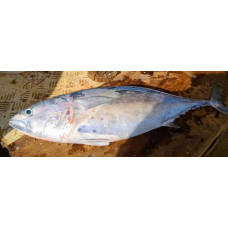Latin name
Euthynnus affinis
Other names
Little tuna, wavyback skipjack tuna, kawakawa, tongkol komo.
Identification
They have a spindle-shaped dense body, rounded in cross section. The teeth are small, conical, arranged in a single row. There are 27-30 teeth on the upper jaw and 24-27 teeth on the lower jaw. There are 29-33 stamens on the first gill arch. Behind the anal fin is a row of 6-8 small fins. There is a long medial keel on either side of the caudal peduncle and 2 small keels on either side of it closer to the caudal fin. The number of vertebrae is 39. Except for the carapace in the anterior part of the body and the lateral line, the skin is bare. Swim bladder is absent.
Features of fish fins
There are 2 dorsal fins. The first dorsal fin has 10-15 rays. The distance between the dorsal fins is small, not exceeding the length of the eye. The front rays of the first dorsal fin are much longer than the middle and back rays, giving the fin a concave shape. The second dorsal fin is much lower than the first. Behind the second dorsal fin is a row of 8 small fins. The pectoral fins are short, made up of 25-29 rays. They do not reach the imaginary line drawn through the beginning of the gap between the dorsal fins. Between the pelvic fins there is a low bifurcation. The anal fin has 13-14 soft rays.
Fish colouring
Back bluish black with numerous dark oblique stripes. Belly silvery white. There are 3 or more grayish spots under the pectoral fins. Fins are black or gray, pelvic fins are black with a white edge. There is a dark spot under each eye.
Distribution
Widespread in subtropical and tropical waters of the Indian and Pacific Oceans. Its range extends from South Africa to Japan and Hawaii.
Habitat
These are tropical pelagic and neritic fish. Water temperature in the range of 18-29°C. Occurs in open waters, but always stays close to the shore. Juveniles may enter bays and harbors.
Size
The maximum length is 100 cm. Normal length is 60 cm. Maximum declared weight is 13.6 kg. Maximum registered age is 6 years.
Behavior
They are packy, sometimes forming schools with Yellowfin Tuna, Skipjack Tuna and Auxis that can range from 100 to 5000 individuals.
Food and feeding habits
These adaptable predators feed on small fish such as herring and old world silversides, crustaceans and squid. These in turn become prey for large tunas, marlins and sharks. Because of their abundance and wide distribution, these fish are an important part of the trophic chain.
Reproduction
They reproduce by spawning. Eggs are spawned in batches. Mature fish are caught throughout the year, but the time of spawning depends on the area where they live. In Philippine waters, the peak breeding season is from March to May; in the Seychelles, there are two seasons - October-November and April-May; off the coast of East Africa, from January to July; and in Indonesian waters, from August to October. In the Indian Ocean, the fecundity of a female 48 cm long and weighing 1.4 kg was 0.21 million eggs per spawning and 0.79 million eggs per spawning season, while for a female 65 cm long and weighing 4.6 kg, these figures were approximately 0.68 million and 2.5 million eggs, respectively. In juveniles, the sex ratio is equal, while in adults, males predominate. Off the coast of India, sexual maturity occurs at 43 cm, while in Taiwanese waters, eastern small tunas begin spawning at two years of age.
Fishing
They are fished commercially. Mackerel tuna are caught with gillnets, purse seines, trolling and long lines.
Relationship with a person
Table fish. Has tasty but perishable flesh.
| Classification | |
| Phylum | Chordata |
| Class | Actinopterygii |
| Squad | Scombriformes |
| Family | Scombridae |
| Genus | Euthynnus |
| Species | E. affinis |
| Features | |
| Conservation status | Least Concern |
| Habitat | Pelagic |
| Life span, years | 6 |
| Maximum body weight, kg | 13,6 |
| Maximum length, cm | 100 |
| Sailing speed, m/s | No information |
| Threat to people | Edible |
| Way of eating | Predator |
Mackerel tuna
Tags: mackerel tuna

